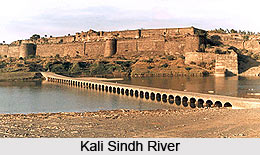 The Kali Sindh River is an Indian river flowing in the Malwa region of Madhya Pradesh state. The Kali Sindh originates from Bagli in Madhya Pradesh. The origin point of the river is Vindhya Range and then flowing down further to the north direction through Baran and Jhalawar district. The river then joins Chambal River at the downstream of Sawai Madhopur in Rajasthan state. It belongs to the Ganga Basin. The river belongs to the Yamuna basin, being one of the perpetual streams of the state; it is fed by Ahu, Niwaj and Parwan Rivers. This river plays a major role in the irrigation system of the state. Madhya Pradesh is a prominent state of India where the river covers the maximum portion of Malwa region.
The Kali Sindh River is an Indian river flowing in the Malwa region of Madhya Pradesh state. The Kali Sindh originates from Bagli in Madhya Pradesh. The origin point of the river is Vindhya Range and then flowing down further to the north direction through Baran and Jhalawar district. The river then joins Chambal River at the downstream of Sawai Madhopur in Rajasthan state. It belongs to the Ganga Basin. The river belongs to the Yamuna basin, being one of the perpetual streams of the state; it is fed by Ahu, Niwaj and Parwan Rivers. This river plays a major role in the irrigation system of the state. Madhya Pradesh is a prominent state of India where the river covers the maximum portion of Malwa region.
Origin of Kali Sindh River
The origin of the Kali Sindh River is from northern slope of Vindhya Mountains and it moves northwards, through the Jhalawar and Baran districts. The river enters from Madhya Pradesh to Rajasthan near village Binda. After flowing 145 km in Rajasthan, the Kali Sindh River merges in Chambal River near Nanera village of District, Kota. The river covers a large portion of the land in Madhya Pradesh before entering the Rajasthan state in India. The total distance covered by the Kali Sindh River in Rajasthan is 145 km.
Course of Kali Sindh River
The Kali Sindh River starts off on the Malwa Plateau located in Vidisha district. The river flowing northeast covers districts such as Ashokanagar, Guna, Bhind, Datia, Gwalior and Shivpuri of Madhya Pradesh, which further merges with Yamuna River in Etawah district of Uttar Pradesh.
Tributaries of Kali Sindh River
Like discussed earlier, the Kali Sindh River tributaries are:
•Parbati: Originating from the northern slopes of Vindhya Range in Madhya Pradesh, it branches out from Kali Sindh River further flowing in Baran district of Rajasthan state. It flows through Jhalawar district and the Kota district of the state. The Parbati River catchment is approximately 3180 square miles. The river from these districts of Rajasthan finally merges at the right bank of Chambal River.
•Pahuj: Pahuj River is the waterway flowing through the historical city of Jhansi situated in Uttar Pradesh. It is the tributary of Kali Sindh River that further joins the Yamuna River in Etawah of Uttar Pradesh state. The river has also been given another name "Pushpavati" in several religious texts.
•Mahuar: Flowing from the state of Madhya Pradesh, Mahuar River is the tributary of Kali Sindh River. It is not a small river, but during summers the water levels dips. However, the river still runs deep enough to give a cool dip during scorching months.
•Kunwari: Kunwari River flows in Bhind, Morena districts of Madhya Pradesh. The river has been branched out of Kali Sindh River and merges with Yamuna River in the Etawah district. Districts like Kailaras, Sheopur, Morena and Bijeypur are situated on the banks of this river.
Kali Sindh Thermal Power Project, Jhalawar
Kali Sindh Thermal Power Project is located in Jhalawar. The proposed capacity of coal based Thermal Power Project is 1200 MW. Its catchment area is about 7944 sqkm in Jhalawar & Kota District. Manikheda Dam has been built across the Kali Sindh River where the majority of the surrounding regions are benefiting through this. The drinking water and irrigation requirements are facilitated through this river.















